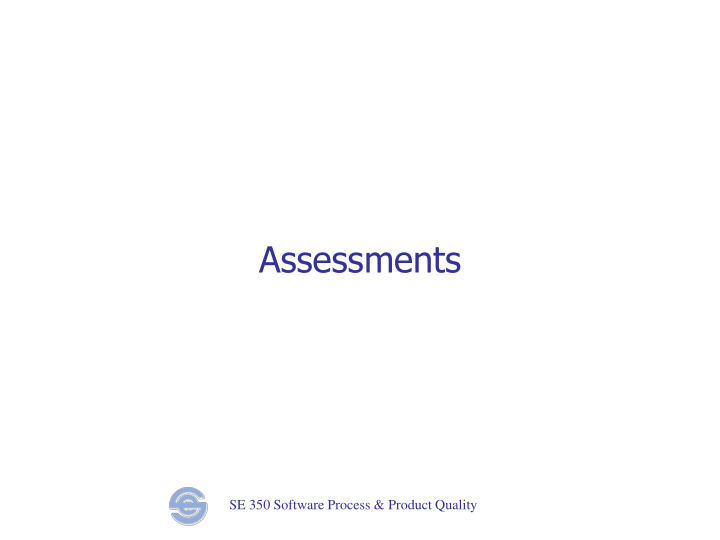



Assessments SE 350 Software Process & Product Quality
Topics Assessment Objectives Assessment Criteria Assessment Process Assessment Results and Presentation Cost/Benefit Trade-offs Assessment Approach matched with Quality Philosophy SE 350 Software Process & Product Quality
Assessments Metrics and feedback on process effectiveness Identify improvement opportunities, transfer learnings SE 350 Software Process & Product Quality
Assessment Objectives Determine whether criteria are being met: quality practices being followed Generate compliance metrics Identify opportunities for improvement Identify good practices and strengths to be maintained Transfer of learnings: identify and propagate “best practices,” suggestions from outside Assessees also get a chance to “step back and take a look at what they are doing” SE 350 Software Process & Product Quality
Assessments Exercises where someone comes in to assess actual practices against some quality criteria: Assess compliance to standards such as ISO 9000 Assess against model (such as CMM, Malcolm-Baldrige) Assess against goals (extent to which practices achieve quality goals) More flexible Requires more competence from assessors Does not standardize practices Assess based on results Ultimate in goal-orientation But results not totally under control of engineers Good results do not guarantee good practices (heavily influenced by external factors) May be internal or external assessment, formal or informal SE 350 Software Process & Product Quality
Assessment Criteria May be very high-level objectives Organization only needs to demonstrate that their practices are good enough to achieve the objectives For example, “Project progress is tracked against plans, and lack of adequate progress causes appropriate actions to be taken” Provides a lot of flexibility in finding the right ways to achieve objectives More dependent on assessor’s judgment Sometimes, even the objectives may not be relevant! For example, project is a long- term “opportunity project” that is run in background mode with few deadlines May be very specific in terms of practices Specifying practices makes assessment easier For example, “Project has GANTT charts showing the plan, progress is tracked every week, and replanning done if more than 2 weeks late” Much more likely that practices will be mismatched to situation needs and become burdensome SE 350 Software Process & Product Quality
Assessment Process Assessment scheduled, assessors selected Project prepares data for assessment Project artifacts, evidence of practices Documents describing project goals, practices/processes Possibility of manufacturing (false) evidence! Assessors go through data, come up with questions and areas to examine further “Site visit” – assessors interact with project staff, ask questions about practices, obtain clarifications, perform cross-checks (between evidence and what people say) Assessors discuss, develop, and present conclusions, including recommendations for improvement SE 350 Software Process & Product Quality
Evidence Assessments tend to look for evidence (documentation) The greater the emphasis on documented evidence, the greater the burden of preparing for assessment, and the weight of processes Add subjective inputs (interviews with people involved to ask about practices and effectiveness) Can do more of this with self-assessment, where goals are clearly formative Doers are most familiar with problems, and often, the ones most interested in fixing them Improves ownership of goals SE 350 Software Process & Product Quality
Evaluation Correlate all the data, from multiple assessors and from different sources May use results as additional inputs on effectiveness SE 350 Software Process & Product Quality
Presenting Results Constructive focus Strengths and opportunities for improvement, not weaknesses Keeping ownership of results with people doing the job Most assessments are primarily formative SE 350 Software Process & Product Quality
Value of Assessments Compliance: Make sure processes are followed Education: Engineers become familiar with goals and practices, sends message about quality focus Standardize practices Identification of strengths to sustain, weaknesses to improve 2-way cross-fertilization of good practices Assessors typically from other projects / organizations (Internal vs. external assessment) Generates metrics/certificates that provide evaluative information SE 350 Software Process & Product Quality
Cost of Assessments Effort for assessment preparation is often significant Engineers’ and assessors’ time May lead to additional project activities that are conducted solely for assessments such as making sure evidence exists, filling holes that assessors consider important but project staff would not prioritize Possibility of externalizing excellence Internal compass of excellence vs. satisfying external evaluators For example, exams and grades! SE 350 Software Process & Product Quality
Assessment Approach Selection: Matching to Culture Hierarchical organizations may prefer process/practices orientation: standardized practices, goal ownership with manager, requires minimal maturity from engineers TQM-style approach expects goal ownership with engineers, local optimization of practices, high maturity levels from engineers, needs goal-oriented assessment If assessment is mismatched with execution style, will become less meaningful exercise, also detract from culture Possibility of losing internal compass of excellence SE 350 Software Process & Product Quality
Conclusion Assessments provide in-depth understanding of process quality Areas to preserve/enhance, areas to improve Assessments “force” the organization to think carefully and deeply about their process Is the benefit worth the (non-trivial) cost? Organization’s quality culture approach should align with how assessments are done and how results are used SE 350 Software Process & Product Quality
Recommend
More recommend